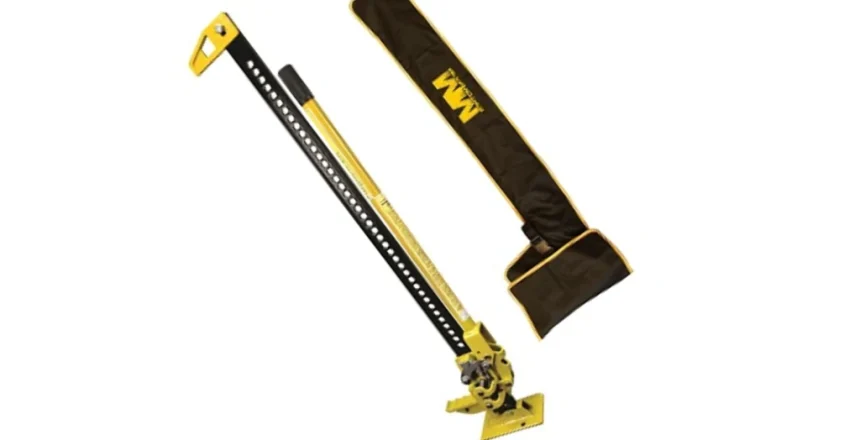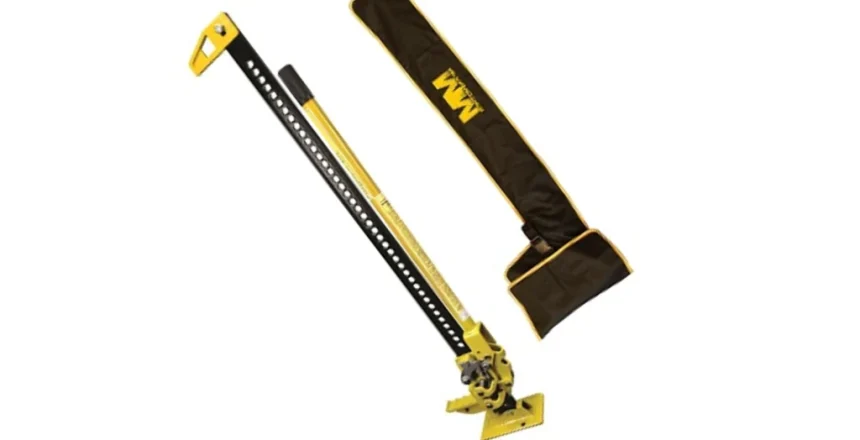Safety reminder: Always follow manufacturer instructions and safety guidelines when using lifting equipment.
Mean Mother High Lift Jack – 48 Inch Review & Safe Use Guide (Australia)
Excerpt: This hands‑on guide to the Mean Mother High Lift Jack explains what it does, how to use it safely, and how it compares with similar tools. Built for 4WD recovery and tough jobs, it’s also useful for rural properties, community groups, and emergency preparedness.
Last updated: 13 August 2025
Overview: What is the Mean Mother High Lift Jack?
The Mean Mother High Lift Jack is a tall, mechanical ratcheting jack designed to lift, clamp, or winch heavy loads. The 48‑inch configuration offers extra travel for lifted 4WDs, farm machinery, and recovery scenarios where a standard scissor or bottle jack can’t reach or deliver enough height.
In Australian settings—from remote tracks to rural properties and volunteer brigade sheds—this style of jack is valued for its versatility. It can help reposition a stuck wheel, lift a bumper or rock slider to place traction boards, or act as a manual press or spreader in controlled non‑rescue contexts. While it’s not a replacement for hydraulic rescue equipment, it’s a capable tool for preparedness and property maintenance.
This bundle includes a protective carry bag, which keeps the mechanism clean and the long steel bar less likely to mark interiors or ute trays. That bag matters: grit and dust accelerate wear, and the jack’s safety depends on a smooth‑running climbing mechanism.
If you’re a firefighter, SES volunteer, ranger, or a member of the public who travels off‑road, a high lift jack provides a simple, field‑serviceable way to create controlled lift or pull—when paired with the right accessories and a conservative safety plan.
Key Features & Specs (48″ + Carry Bag)
Height & Travel
48″ (approx. 1220 mm) bar suits lifted 4WDs, bullbars, and farm equipment where extra clearance is needed.
Construction
All‑steel or steel with cast components; large base plate; climbing pins for controlled ratcheting under load.
Working Load
Manufacturer‑stated capacity (check label). Always keep within the marked WLL, and never place any part of your body under a load supported only by the jack.
Recovery Uses
Lift, clamp, or limited winching with chains/straps; seat tyre beads; press components in the field (with care).
Carry Bag
Protects the mechanism, reduces cabin mess, and makes stowing easier in wagons and utes.
Compatibility
Use with rated recovery points, jacking adaptors for sliders/bullbars, and a load‑rated base on soft ground.
How It Works: Ratcheting Lift, Pin by Pin
A high lift jack uses a climbing mechanism with two alternating pins on a perforated steel bar. As you move the handle, one pin holds the load while the other “climbs” to the next hole. Repeating this action raises or lowers the carriage in small, controlled increments. The direction selector toggles between lift and lower.
For vehicle use, fit a purpose‑made adaptor to a solid jacking point (rock slider, jackable bullbar, tow point designed for lifting). Stabilise with a wide base plate on sand or mud. Keep bystanders well clear of the sweep zone of the handle—it can recoil with force if the load shifts.
To lower, change to down and maintain a firm two‑handed grip on the handle, guiding it deliberately as the jack steps down. Never let the handle fly—this is where most injuries occur.

Advertisement
Shop High Lift Jacks at Outback Equipment
Supporting links may earn us a commission at no extra cost to you.
Why Choose the Mean Mother High Lift Jack?
The Mean Mother High Lift Jack provides three distinct capabilities in one tool: lifting, clamping, and controlled pulling. In remote areas, that versatility can be the difference between a simple self‑recovery and a long wait for assistance. For brigades and community groups, it can assist with non‑critical tasks such as repositioning heavy gates, fencing, or equipment for maintenance.
- Excellent vertical travel for lifted vehicles and awkward terrain.
- Manual, mechanical system—no batteries or hydraulics to fail in the field.
- Field‑serviceable: pins and springs can be inspected and replaced when worn.
- Carry bag keeps grit out and reduces corrosion and accidental damage.
- Works with a broad ecosystem of bases, adaptors, and recovery straps.
Best results come from pairing the jack with traction boards, a shovel, a proper base plate, and an understanding of load paths and centre of gravity. Small, thoughtful changes—like removing cargo from roof racks before lifting—make the operation safer and faster.
Limitations & Safety Considerations
- Instability risk: A tall jack is inherently tippy. Use a wide base on soft ground, chock wheels, and lift only as high as required.
- Handle kickback: Maintain a controlled grip while lowering; never straddle the handle sweep path.
- Load limits: Stay within the marked WLL; avoid shock loads and side loading.
- Not a body support: Never work under a vehicle supported solely by the jack—use properly rated stands on firm ground.
- Corrosion & contamination: Sand and rust reduce pin engagement. Clean and lubricate after trips.
- Rescue context: Do not use as a substitute for certified rescue tools or techniques.
Store with the mechanism lightly lubricated, handle secured, and the bar protected by the carry bag. Inspect pins, springs, and the climbing mechanism before each use.
User Scenarios: Field Examples
Volunteer Brigade (Training)
A rural brigade uses the jack to lift a trailer drawbar onto stands for maintenance. Crew practise safe handle control, chocking, and base plate use on gravel to build muscle memory for real operations.
4WD Self‑Recovery
On a rutted track, a driver lifts the front slider a few notches, places stones and boards, then lowers gently to regain clearance. The jack also helps reseat a bead in camp using controlled pressure (with appropriate technique).
Homestead Maintenance
A property owner uses the jack as a clamp to press a warped gate hinge back into alignment before refastening—saving a trip to town for specialised tools.
Maintenance & Care Guide
Reliability comes from small habits. After dusty or salty trips, rinse the bar with fresh water, dry thoroughly, and apply a light oil to the climbing mechanism and pins. Check the springs for tension and the base for distortion.
- Inspect pins for rounding or mushrooming; replace if worn.
- Keep the release mechanism free of grit—use compressed air or a soft brush.
- Lubricate sparingly; excess oil attracts dust.
- Store inside the carry bag and out of direct weather when possible.
- Record a service note after significant lifts or recoveries.
An annual strip‑down and deep clean is recommended for frequently used jacks. Replace any deformed parts only with manufacturer‑approved spares.
Comparison: Similar High Lift Options
| Model | Bar Height | Notable Features | Best For |
|---|---|---|---|
| Mean Mother High Lift Jack 48″ (with bag) | 48″ | Carry bag; broad accessory compatibility; value‑forward package. | General 4WDing, rural maintenance, volunteer training. |
| ARB Jack / Hi‑Lift style 48″ | 48″ | Premium finish; large accessory range; strong dealer network. | Frequent users seeking premium support. |
| Budget Farm‑Jack 48″ | 48″ | Low cost; basic components. | Occasional use with strict inspection and conservative loads. |
FAQs: Mean Mother High Lift Jack
Is a 48″ jack too tall?
It’s ideal for lifted 4WDs or uneven terrain. For standard‑height vehicles, a shorter bar may be easier to manage.
What’s the safe working load?
Always check the label for the marked WLL and never exceed it. Avoid side loads or shock loads.
Can I use it to winch?
Yes, for short pulls using chains/straps rated above the load. Keep people clear and control each ratchet step.
How do I stop the handle from kicking back?
Lower slowly with two hands, standing to the side, and keep a firm grip. Control the handle at all times.
What accessories do I need?
A wide base, adaptor for sliders/bars, chocks, gloves, and traction boards. Consider protective eyewear.
Is it suitable for rescue?
Not as a substitute for certified rescue tools. Use only in non‑rescue contexts unless trained and authorised under a formal plan.
How do I store it?
Clean, dry, lightly lubricated, and in the carry bag. Secure the handle and stow to prevent movement in transit.
Where to Buy in Australia
- Outback Equipment – broad 4WD recovery range and accessories.
- 4WD Supacentre – bases, adaptors, and recovery gear.
- ARB – premium accessories and nationwide stores.
- Autobarn – convenient metro locations and consumables.
Compare stock, shipping times, and included accessories (e.g., base plate, adaptors, or storage hardware) before purchasing.
Links & Manuals
- Mean Mother Australia – Official site (check product page for manuals and parts).
- AS/NZS 2693: Vehicle Jacks (Standards Australia) – reference only; purchase or access via library.
- Safe Work Australia – Hazardous manual tasks & lifting guidance.
Always confirm the latest documentation for your exact jack model and follow the stated procedures and limits.
Credits & Review Notes
This review blends hands‑on experience with general best‑practice guidance used by Australian 4WD communities and emergency services trainers. It is not a substitute for formal training or manufacturer instructions. Conditions and equipment vary—adjust techniques accordingly.
Emergency Contacts – Quick List (Australia)
- 000 – Fire, Police, Ambulance
- 131 444 – Police Assistance (non‑urgent)
- 132 500 – SES (storm/flood help)
- Local 4WD club or land manager for track conditions
Have a charged phone, offline maps, and a back‑up plan before heading remote.
Quick Maintenance Tips
- Brush off grit after each use; wipe bar clean.
- Lightly oil pins, springs, and climbing mechanism.
- Check base plate and nose for deformation.
- Store in the carry bag; secure handle during transport.
- Replace worn parts with manufacturer components only.
For Professionals: Training & Risk Control
Incorporate the jack into competency‑based training with clear lift plans, exclusion zones, and tool checks. Emphasise base selection, load paths, handle control, tag‑out for defects, and conservative lift heights. Document an operational risk assessment for each scenario and designate a spotter to manage the handle sweep zone.
Disclaimer
Always follow safety protocols and training when using equipment. This content is general in nature and does not replace manufacturer instructions or formal qualifications.



